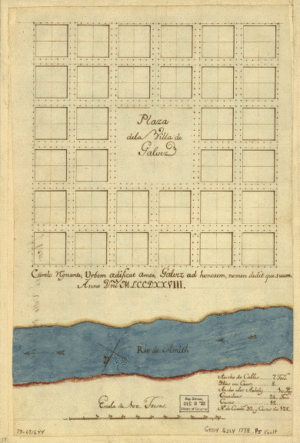Galveztown, Louisiana facts for kids
Quick facts for kids
Galveztown
Villa de Gálvez (Spanish)
|
|
|---|---|

Official plan for Galveztown.
|
|
| Country | |
| State | |
| Parish | |
| MCD | Parish Governing Authority District 5 |
| Historic colonies | Louisiana (New Spain) Louisiana (New France) |
| Established | November 22, 1778 |
| Abandoned | 1810 |
| Named for | Bernardo de Gálvez |
| Elevation | 5 m (16 ft) |
| Time zone | UTC−6 (Central) |
| • Summer (DST) | UTC−5 (Central) |
| ZIP code |
70769
|
| Area code(s) | 225 |
| GNIS feature ID | 540630 |
Galveztown (/ˈɡælvɛztaʊn/), also known as Villa de Gálvez (Spanish: [ˈbiʝa ðe ˈɣalβes]), was a ghost town in Louisiana. A ghost town is a place that used to be a busy settlement but is now mostly empty. Galveztown was located where the Bayou Manchac and the Amite River meet, in Ascension Parish, Louisiana.
This town was started in 1778. It was settled by people from the Canary Islands (called Isleños) and Anglo-Americans. These Anglo-Americans were Loyalists, meaning they supported the British during the American Revolutionary War and were fleeing from American Revolutionaries.
Life in Galveztown was very hard. People faced tough conditions and many diseases. Because of these problems, the town was eventually left empty. Many residents moved to Spanish Town in 1806. Some people stayed nearby and later started a new community called Gálvez, Louisiana.
Contents
The Story of Galveztown
In 1778, people loyal to the British, called Loyalists, moved to the Amite River area. They were running away from American Revolutionaries. In November of that year, the first ship carrying Canary Islanders arrived in Spanish Louisiana. They came to help defend the land from a possible British attack.
The Spanish Governor, Bernardo de Gálvez, traveled up the Mississippi River. He was looking for a good place to build a new settlement for the Isleños. On November 22, he found a small group of Anglo-American, French, and German settlers where the Amite River and Bayou Manchac met.
Governor Gálvez offered these settlers a safe place to live. In return, the Isleños would also settle there, and a Spanish fort and soldiers would be built. The settlers agreed. They named their new home "Villa de Gálvez" or "Galveztown" to honor Governor Gálvez.
Challenges During the American Revolution
From the very start, Galveztown faced many problems. Diseases like smallpox and scabies caused many people to get sick and even die. Governor Gálvez sent medical help, but other illnesses continued to trouble the community.
Despite these challenges, the soldiers from Galveztown were brave. In August 1779, they captured a British outpost called Amite. They also took 7 ships and 125 British soldiers and sailors. At the same time, Governor Gálvez captured other British forts nearby. After the Spanish captured Mobile in 1780, Galveztown became less important for military plans.
The community continued to suffer from diseases. By the winter of 1780, more than one-third of the Isleños who had come to Galveztown had died. On August 24, 1780, a strong hurricane hit Louisiana. It destroyed many homes and ruined crops in Galveztown. Many people lived in poverty and did not have enough food or clothes. The town's population only grew a little after the American Revolutionary War ended.
Why Galveztown Was Abandoned
By 1786, more than half of the houses in Galveztown were empty and falling apart. Many residents asked Governor Miró for permission to leave. A lot of them wanted to move to another Isleño community called San Bernardo.
In 1794, a series of hurricanes caused floods and destroyed homes again. They also ruined the crops. Right after this, the Amite River flooded, affecting every family in Galveztown.
Even with repeated floods and hurricanes, the residents tried to rebuild and survive. However, when the Louisiana Purchase happened, many Isleños decided to leave the settlement for good. The Louisiana Purchase was when the United States bought a huge amount of land from France in 1803. Many Isleños wanted to stay in Spanish territory. So, they moved mostly to Baton Rouge and started a neighborhood called Spanish Town.
The last wedding in Galveztown took place in February 1807. Other residents stayed in the area and later built the community of Gálvez on higher ground, where it was safer from floods.
Studying and Preserving the Site
In 1962, a historical marker was placed at the old site of Galveztown. This marker helps people remember the town's history.
Since 1980, archaeologists have been studying the former site of Galveztown. They have found many old items from the community. They have also figured out where some of the buildings might have been. Students from Louisiana State University can even take classes to study this important historical location.
Galvez Town Today
Today, "Galvez Town" is a populated area within Prairieville, Louisiana. It is located around where the original Galveztown used to be.



